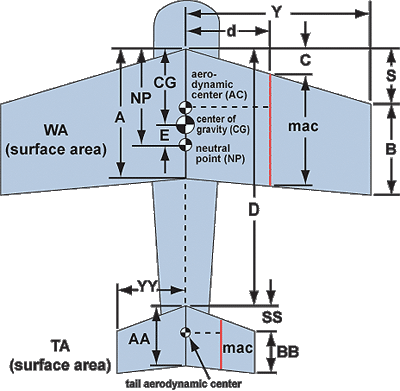This Aircraft Calculator is used to calculate the
Center of gravity and balance of your aircraft. I hope this is helpful.
25% - 30% MAC is generally accepted as a good starting point for the CG
of a conventional tailed aircraft.
|
|
A
i r c r a f t S u p e r C a l c u l a t o r
6 . 1 |
||||||||||||||||||||||||||||||||||
|
MAC And
Neutral Point
If no changes are seen in results after updating an input field, then click BOTH compute/refresh buttons. |
use
the same units of measure (inches or feet) for all entries!
The Equations
|
|||||||||||||||||||||||||||||||||
|
Enter the following data: |
Wing
|
Tail
|
||||||||||||||||||||||||||||||||
|
Root Chord (A,
AA) :
|
|
|
||||||||||||||||||||||||||||||||
|
Tip Chord (B, BB)
:
|
|
|
||||||||||||||||||||||||||||||||
|
Sweep Distance
(S, SS) :
|
|
|
||||||||||||||||||||||||||||||||
|
Half Span (Y, YY)
:
|
|
|
||||||||||||||||||||||||||||||||
|
Distance between wing
& tail root LE's (D) :
|
|
|||||||||||||||||||||||||||||||||
|
Desired Static
Margin
(5% = twitchy 20% = mushy 10% - 15% recommended) : |
|
|||||||||||||||||||||||||||||||||
|
|
||||||||||||||||||||||||||||||||||
|
Weight And
Balance
|
||||||||||||||||||||||||||||||||||
|
Weight
|
Arm
|
|||||||||||||||||||||||||||||||||
|
Left Main Wheel :
|
|
|
||||||||||||||||||||||||||||||||
|
Right Main Wheel
:
|
|
|
||||||||||||||||||||||||||||||||
|
Nose or Tail
Wheel :
|
|
|
||||||||||||||||||||||||||||||||
|
Pilot :
|
|
|
||||||||||||||||||||||||||||||||
|
Passenger :
|
|
|
||||||||||||||||||||||||||||||||
|
Fuel Tank
(gallons of gas) :
|
|
|
||||||||||||||||||||||||||||||||
|
|
||||||||||||||||||||||||||||||||||
|
Datum Point from
Wing Root LE :
|
|
|||||||||||||||||||||||||||||||||
|
Wing Root Chord
(A) :
|
|
|||||||||||||||||||||||||||||||||
|
Sweep
length at MAC :
|
|
|||||||||||||||||||||||||||||||||
|
MAC
length :
|
|
|||||||||||||||||||||||||||||||||
|
For
more accurate results, enter the values for Sweep Length and MAC
computed from the "MAC and NP" calculator above (shown below in yellow). |
||||||||||||||||||||||||||||||||||
|
Calculated
Results
|
||||||||||||||||||||||||||||||||||
|
Mean
Aerodynamic Chord (MAC) =
|
|
|||||||||||||||||||||||||||||||||
|
MAC
distance from root chord (d) =
|
|
|||||||||||||||||||||||||||||||||
|
Wing
Aerodynamic Center aft of root LE =
|
|
|||||||||||||||||||||||||||||||||
|
Ideal
Center of Gravity %MAC =
|
|
|||||||||||||||||||||||||||||||||
|
Actual
Center of Gravity %MAC =
|
|
|||||||||||||||||||||||||||||||||
|
Ideal
CG aft of root LE =
|
|
|||||||||||||||||||||||||||||||||
|
Actual
CG aft of root LE =
|
|
|||||||||||||||||||||||||||||||||
|
Actual
CG from main axle (neg. is aft) =
|
|
|||||||||||||||||||||||||||||||||
|
Neutral
Point %MAC (NP) =
|
|
|||||||||||||||||||||||||||||||||
|
Neutral
Point aft of Wing's root LE (NP) =
|
|
|||||||||||||||||||||||||||||||||
|
Distance
between Ideal CG and NP (E) =
|
|
|||||||||||||||||||||||||||||||||
|
Distance
between Actual CG and NP =
|
|
|||||||||||||||||||||||||||||||||
|
Desired
Static Margin % =
|
|
|||||||||||||||||||||||||||||||||
|
Actual
Static Margin % =
|
|
|||||||||||||||||||||||||||||||||
|
Gross
Takeoff Weight of Aircraft =
|
|
|||||||||||||||||||||||||||||||||
|
Empty
Weight of Aircraft =
|
|
|||||||||||||||||||||||||||||||||
|
Other useful results |
||||||||||||||||||||||||||||||||||
|
Wing
Area =
|
Tail
Area =
|
|||||||||||||||||||||||||||||||||
|
Wing
Apsect =
|
Tail
Aspect =
|
|||||||||||||||||||||||||||||||||
|
Wing
Taper =
|
Tail
Taper =
|
|||||||||||||||||||||||||||||||||
|
W
sweep C =
|
T
sweep CC =
|
|||||||||||||||||||||||||||||||||
|
Tail
MAC =
|
T
MAC dist =
|
|||||||||||||||||||||||||||||||||
|
Tail
Arm =
|
Vbar
=
|
|||||||||||||||||||||||||||||||||
|
Lt
wheel mnt =
|
Rt
wheel mnt =
|
|||||||||||||||||||||||||||||||||
|
Center
wheel mnt =
|
Pilot
mnt =
|
|||||||||||||||||||||||||||||||||
|
Passngr
mnt =
|
Tank
mnt =
|
|||||||||||||||||||||||||||||||||
Developed by Geistware
of Indiana© ., 1999.
Updated May 3, 2005
